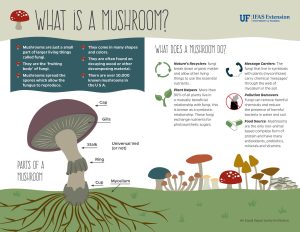Fungi Facts
Fungi are known as plants that lack chlorophyll and true plant parts rather they are decomposers that can contain mycelium and mycorrhizae. As a member of the animal kingdom, fungi consist of yeast, toadstools, mold, mildew, truffles, and MUSHROOMS. Mushrooms are fleshy spore-bearing fungus categorized as edible and non-edible organisms. There are an estimated 14,000 mushroom species with 3,000 being known as edible.
Some unique facts about mushrooms are:
- Heterotrophic: Need carbon to survive that is pulled from living or decaying organisms
- Saprotrophic: live and feed on dead/decaying organic matter
- Mycelium: colony of roots for fungi
- Mycorrhizae: colony of roots that pull nutrients from the soil to the plant or fungus. Symbiotic relationship.
A true mushroom consists of a cap, gills, ring, stalk, volva, and mycelium as shown below.

Edible vs Non-Edible
When partaking of mushrooms it is strongly recommended to only eat mushrooms that are store bought or have been grown at home using the proper growing techniques. MUSHROOMS FOUND IN THE HOME LANDSCAPE SHOULD NOT BE EATEN AS THEY MAY NOT BE EDIBLE. Foraging for edible mushrooms is a unique skill that many people acquire over years of practice. The mushroom kingdom is riddled with doppelgangers of edible and non-edible mushrooms so be VERY careful.
Here are a few commonly commercially produced mushrooms that we tend to enjoy in various meals:
- Shiitake (lentinula edodes)
- White Button (agaricus bisporus)
- Cremini (agaricus bisporus)
- Portobello (agaricus bisporus)
- Oyster (Pleurotus ostreatus)
- Enokitake (flammulina velutipes)
While here we have a few wild edible mushrooms that tend to be viewed as hot commodities in the culinary world:
- Morels (morchella angusticeps)
- Maitake (grifola frondose)
- Giant Puffball (calvatia gigantea)
- Shaggy Mane (Coprinus comatus)
- Black Trumpet (craterellus cornucopioides)
- Porcini (boletus edulis)
- Chanterelles (Cantharellus cibarius)
- Matsutake (tricholoma matsutake)
- Caesar’s Mushroom (Amanita caesarea)
Non-Edible Mushrooms
These are the mushrooms that are recommended do not eat in any capacity as they will cause intestinal issues or can be fatal. Amanita Muscaria is typically found in the woods in fairy rings and also on various levels of the video game Super Mario Bros. This mushroom is fatal to humans when ingested and should be admired from a far.

Amanita Virosa is commonly know as the “Death Angel” and is not found in North America however, its cousin Amanita Bisporigera is and both are fatal to humans when ingested. These mushrooms look similar to the white buttons often found in local grocery stores due to there white caps but are completely different.


Mushrooms at Home
Growing mushrooms at home can be a fun family project although sampling mushrooms in different recipes can be even better. To get started growing your fungi, you can purchase and pre-inoculated kit, purchase a grown bag and inoculate with the proper substrate for production, or create your own spawn to inoculate. For first time growers or family projects perhaps using a ready made kit may be the best route.
Mushroom growing is a sterile process to prevent bacteria from interfering with the development process. For more information on mushroom production, check out the following links:
- https://branding.ifas.ufl.edu/downloads/uploads/Infographics/Agriculture/What-is-a-Mushroom.pdf
- https://www.mushroom-appreciation.com/growing
- https://www.webmd.com/diet/health-benefits-mushrooms
- https://www.uclahealth.org/news/7-health-benefits-of-mushrooms
- https://plantpath.ifas.ufl.edu/extension/mushrooms/
- https://edis.ifas.ufl.edu/publication/SS662
- https://edis.ifas.ufl.edu/publication/MV095
- https://gardeningsolutions.ifas.ufl.edu/plants/edibles/vegetables/growing-mushrooms-at-home.html
For more information on urban horticulture programs and the Master Gardener Volunteer Program in Volusia County, contact Brittany A. Council-Morton via email at bcouncil1@ufl.edu or phone at 386-822-5778.
Source: UF/IFAS Pest Alert
Note: All images and contents are the property of UF/IFAS.



